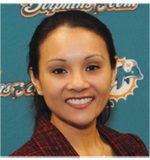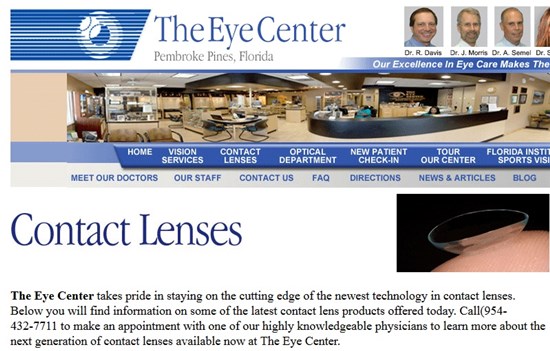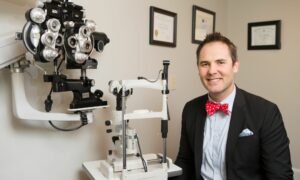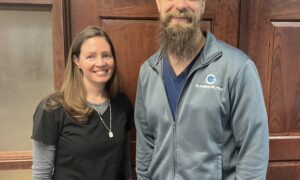By Thuy-Lan Nguyen, OD
September 16, 2015
SYNOPSIS
Specialty contact lenses equip you to addresschallenging vision issues, while expanding revenues and building patient loyalty.
ACTION POINTS
EQUIP YOURSELF. A corneal topographer is helpful, and specialty lens fitting kits from the vendors you work with are necessary.
TRAIN TO SERVE SPECIALTY CL PATIENTS. Local CE courses or courses atlargerconferencesoffer training.
CARVE OUT CHAIR TIME. On average, specialty CL visits may require 30-60 minutes, and visits happen 3-10 times the first year before finalizing their prescription.
Specialty contact lenses equip me to meet a host of challenging patient cases. These cases includepatients who have unique prescriptions or eye diseases such as keratoconus, as well as those seeking orthokeratology to reshape the cornea to reduce myopia and astigmatism. Such cases also providegreat growth opportunity for your practice.
These patients cannot see properly with glasses or standard contact lenses. Specialty contact lenses can be soft disposables, but most are gas permeable or hybrid (gas permeable center with soft outer skirt). I am now on the part-time faculty at Nova Southeastern University College of Optometry, but I formerly owned a practice in Pembroke Pines, Fla., in which I specialized in specialty contact lenses. These cases comprised 20-30 percent of my practice.
Specialty CLs: Three Sample Cases
Keratoconus
I bill for a comprehensive eye examination and a topography, in addition to a specialty contact lens examination and the lenses themselves. I use all types of specialty lenses for these cases, but I have been favoring scleral gas permeables lately. In general, fees range between from $1,500 to $3,000 per year.
Overnight Orthokeratology with CRT lenses
I perform a comprehensive eye exam and topography and a CRT fit with lenses. The fees usually range from $800 – $1,500 for the entire process.
Post-Surgical Patients
The third major category of difficult cases are post-surgical (post-RK, post-LASIK, post-corneal transplant, post PRK) patients. I favor scleral lenses for these patients. The process and fees are similar to keratoconus.
Profitability Potential
Specialty contact lenses were extremely profitable for my practice. Our specialty contact lens revenue was well over $100,000 per year. Profitability from specialty contact lenses is attributable to both higher examination fees, higher profit margins on the materials and higher insurance reimbursement for both. I separated the examination fee from the materials for all contact lenses. But I charged more for specialty contact lenses exams compared to standard exams.
Another reason for better profit with specialty contact lenses is that, in most cases, patients cannot purchase these lenses elsewhere. They cannot take their prescription and purchase online or in big box stores. Doctors also have more control over their fees. Specialty lenses are not subject to manufacturer UPP (Universal Pricing Policy), which made some standard contact lenses the same price no matter where they are purchased, but cut profit margins for everyone also. If presented and fit properly, these patients are so appreciative, they are more than happy to see me faithfully, as well as purchase their lenses only from me.
Opportunity for Growth
Multifocals were a big growing area of my practice, but I was also seeing more and more patients who have keratoconus or have other eye diseases that require unique custom lenses. I got referrals from other optometrists, but also primary care physicians and ophthalmologists. Once I was able to help a patient see better than they have ever seen before, they were loyal, thankful patients for life who referred their friends and family to me also.
Train to Serve Specialty CL Patients
I completed a residency at Nova SouthEastern University in Cornea and Contact lenses. But because contact lens technology is always evolving, I have to constantly evolve, as well. I go to as many contact lens meetings and continuing education as possible. Local industry meetings sponsored by contact lens vendors are a great way to learn the newest technology in soft disposables, torics and multifocals. These meetings are typically free to doctors, but are held in the evenings, so it is more an investment in after-hours time. I also go to other CE conferences, such as the Global Contact Lens Symposium, but all major conferences will offer classes.
Invest in Needed Instrumentation
I relied on my corneal topographer for diagnosing and monitoring corneal diseases and for initial lens fittings. You also have to have diagnostic sets for whichever lens you would like to use. However, you break even on the diagnostic set after one or two fits. Most companies will also send you a set on loan at no charge to their lenses.
A corneal topographer can range between $13,000-$18,000. Fit sets for specialty lenses can range between $200 to $1,200 per set, but I always asked the manufacturer to send me the fit set on loaner first to try it out with patients before purchasing it. Most vendors will let you use their fit set for 30 or 90 days on a trial basis. If you don’t like the lens, you send the fit set back with no charges other than cost of shipping. But if you do like it, some manufacturers will let you keep the fit set, or give you a discount on the set if you order a minimum number of lenses.
Carve Out Chair Time
Specialty CL patients may require more chair time initially and they may require more visits the first year. On average, their visits may require 30-60 minutes, and I may have seen them 3-10 times the first year before finalizing their prescription.
Charge Sufficiently for Your Services
The most common mistake that affects profitability and growth potential of a specialty contact lens practice is not charging enough for your services. I have been a little guilty of this myself. When I took over my last practice, The Eye Center, the examination fees for specialty contact lenses was significantly lower than the industry standard. Since I could not dramatically increase fees to patients overnight, I slowly increased on a yearly basis.
Have the Conversation with Patients
I typically told patients that if I could give them good vision and good comfort with standard soft contact lenses, that was certainly the most convenient for both of us. However, if they are unable to achieve that level of vision and comfort in standard soft lenses, then we need to discuss appropriate treatment. I call it “treatment” for a reason: specialty contact lenses are not cosmetic. In some cases, it is a medically necessary treatment. Many patients are scared of gas permeables because they think they are “hard” or “uncomfortable.” But once a lens is fit properly, and you give your eyes a chance to adjust to them, most patients find them more comfortable than standard lenses, and they cannot imaging wearing anything else.
Thuy-Lan Nguyen, OD, is on the part-time clinicalfaculty of Nova Southeastern University College of Optometry, and formerly the owner of The Eye Center in Pembroke Pines, Fla. To contact her: Ttlnguyen@nova.edu




























